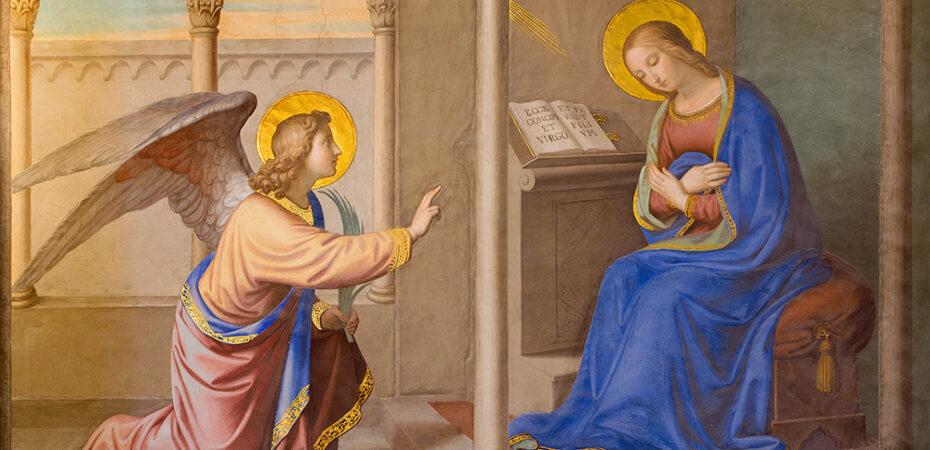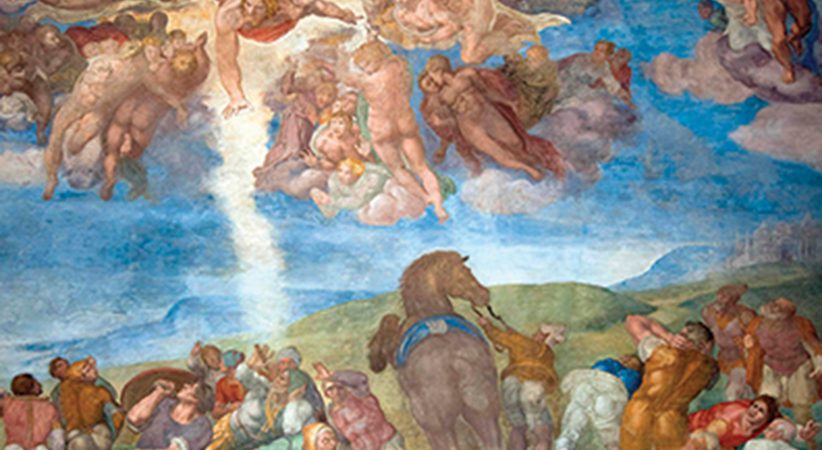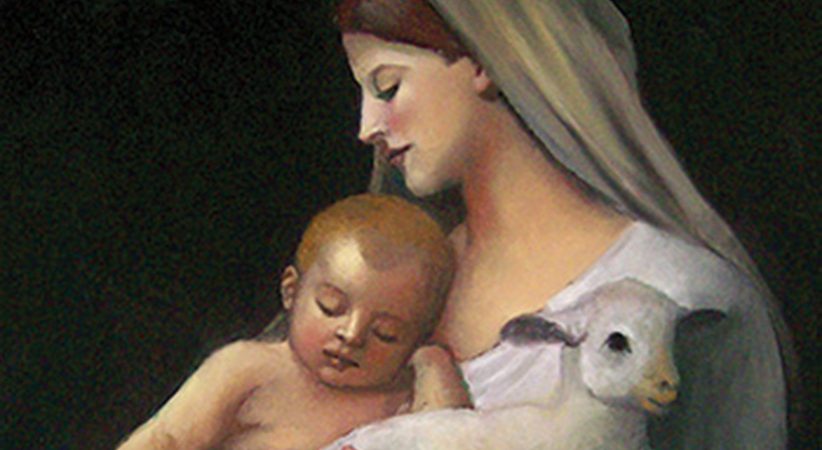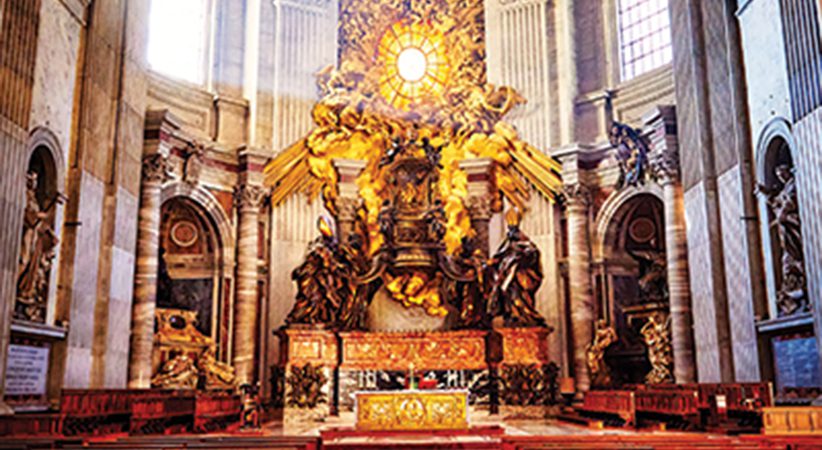‘Be It Done to Me According to Thy Word’
Exploring the essential bond between the Annunciation, the Incarnation and the priesthood
Dr. Robert Fastiggi Comments Off on ‘Be It Done to Me According to Thy Word’
In his 1974 apostolic exhortation Marialis Cultus, Pope St. Paul VI describes the solemnity of the Annunciation as a joint feast of Christ and Mary because it commemorates the Incarnation of the Word of God and “the Blessed Virgin’s free consent and cooperation in the plan of redemption” (No. 6).
Although Holy Thursday rightly celebrates the establishment of the priesthood by Christ, the Annunciation is also essential for the priesthood. In his May 4, 1952, radio message to the Marian Congress of the Union of South Africa, Pope Pius XII notes that “in the loving providence of God, it was Mary’s ‘be it done to me according to thy word’ that made possible the passion and death and resurrection of the divine Redeemer of the world.”
When Mary said yes to the invitation of the angel to become the mother of the Word Incarnate, she spoke “in lieu of that of the entire human nature” (St. Thomas Aquinas, Summa Theologiae, III, Question 30, Article 1).
By receiving the Word of God in her womb and giving flesh to the Divine Redeemer, Mary made possible the sacrifice of Calvary. This is why Pope Francis, in his homily of Jan. 1, 2020, states that “from her, a woman, salvation came forth and thus there is no salvation without a woman.”
Ministry of Priests
According to the Second Vatican Council, the ministry of priests “derives its power and force from the sacrifice of Christ” (Presbyterorum Ordinis, No. 2). The priesthood, therefore, is intimately connected with the fiat of Mary spoken at the Annunciation. The Blessed Virgin’s fiat brought forth the flesh and blood offered at Calvary “for the forgiveness of sins” (Mt 26:28). The priesthood is directed toward sacramental ministry, which culminates in the holy sacrifice of the Mass, which is the unbloody re-presentation of Christ’s sacrifice on the Cross (cf. Council of Trent, Doctrine on the Sacrifice of the Mass; Denzinger-H, 1743). The Council of Trent teaches that Christ established his apostles as priests at the Last Supper “in order that they and other priests should offer his body and blood” (Doctrine on the Sacrifice of the Mass, Canon 2; Denzinger-H, 1752). In the prayer of ordination for priests, the bishop states that Jesus offered himself to God the Father “as a spotless victim; and he made his Apostles, consecrated in the truth, sharers in his mission.” Priests, therefore, carry on the mission of Christ when, acting in his person, they “make present the Eucharistic sacrifice” and offer it to God “in the name of all the people” (Lumen Gentium, No. 10).
The Eucharistic sacrifice, though, is necessarily connected to the Annunciation when the Word became flesh “ex Maria virgine.” In his Holy Thursday Letter to Priests issued on March 25, 1988, St. John Paul II writes: “It is appropriate during this year, being lived by the whole Church as a Marian Year, to recall the reality of the Incarnation as it relates to the institution of the Eucharist and also to the institution of the Sacrament of the Priesthood. The Incarnation was brought about by the Holy Spirit when he came down upon the Virgin of Nazareth and she spoke her fiat in response to the angel’s message (cf. Lk 1:38).
“Hail, true Body, born of the Virgin Mary: you truly suffered and were immolated on the cross for man.
“Yes, the same Body! When we celebrate the Eucharist, through our priestly ministry there is made present the mystery of the Incarnate Word, the Son who is of one being with the Father, who as a man ‘born of woman’ is the Son of the Virgin Mary” (No. 1).
The priesthood, therefore, is intimately linked to the Annunciation because it was only after Mary’s fiat that the Word of God assumed human nature of flesh and blood in her holy and virginal womb.
Annunciation and the Eucharist
In his 2003 encyclical, Ecclesia de Eucharistia, Pope St. John Paul II likewise highlights the significance of the Annunciation for the Eucharist and, therefore, the priesthood: “In a certain sense Mary lived her Eucharistic faith even before the institution of the Eucharist, by the very fact that she offered her virginal womb for the Incarnation of God’s Word. The Eucharist, while commemorating the passion and resurrection, is also in continuity with the incarnation. At the Annunciation Mary conceived the Son of God in the physical reality of his body and blood, thus anticipating within herself what to some degree happens sacramentally in every believer who receives, under the signs of bread and wine, the Lord’s body and blood.
“As a result, there is a profound analogy between the Fiat which Mary said in reply to the angel, and the Amen which every believer says when receiving the body of the Lord. Mary was asked to believe that the One whom she conceived ‘through the Holy Spirit’ was ‘the Son of God’ (Lk 1:30-35). In continuity with the Virgin’s faith, in the Eucharistic mystery we are asked to believe that the same Jesus Christ, Son of God and Son of Mary, becomes present in his full humanity and divinity under the signs of bread and wine” (No. 55).
Formation of Priests

The Annunciation also relates to the formation of priests. Priests are specially configured to Christ, and by virtue of their ordination, they act in persona Christi Capitis — in the person of Christ the Head (cf. Catechism of the Catholic Church, No. 1548).
In his book “Mary and the Priestly Ministry” (Academy of the Immaculate, $39.99), Father Emile Neubert, SM (1878–1967) says that, when Mary conceived and carried the Word in her womb, she “carried all her Son’s future priests in her womb along with him.”
At the Annunciation, the Virgin Mary became the Mother of the Word Incarnate, and she became the spiritual mother of all priests who will be configured to the Person of her divine Son. Just as the baby Jesus was nurtured in Mary’s womb, so seminarians and priests are nurtured by the Blessed Virgin who, in a special way, is their “Mother in the order of grace” (Lumen Gentium, No. 61).
Role of Mary in Formation
On March 25, 1992, the solemnity of the Annunciation, St. John Paul II issued his apostolic exhortation on priestly formation, Pastores Dabo Vobis. In this exhortation, he emphasizes the special role of Mary in the formation of priests: “Every aspect of priestly formation can be referred to Mary, the human being who has responded better than any other to God’s call. Mary became both the servant and the disciple of the Word to the point of conceiving, in her heart and in her flesh, the Word made man, so as to give him to mankind. Mary was called to educate the one eternal priest, who became docile and subject to her motherly authority. With her example and intercession the Blessed Virgin keeps vigilant watch over the growth of vocations and priestly life in the Church.
“And so we priests are called to have an ever firmer and more tender devotion to the Virgin Mary and to show it by imitating her virtues and praying to her often” (No. 82).
The Blessed Virgin gave “a body of flesh” to Christ, the High Priest, at the Annunciation, and she continues to serve as spiritual mother of all priests who are formed in the womb of her maternal care.
Mary’s fiat at the Annunciation provides a model for priests who say “yes” to their call
In his 1891 encyclical Octobri mense, Pope Leo XIII teaches that, when the Son of God was “about to take upon Him our nature” and “consummate thus a mystical union between Himself and all mankind” (No. 4), he “did not accomplish His design without adding there the free consent of the elect Mother, who acted in some way in the role of the human race itself” (No. 4; cf. Summa Theologiae III, Question 30, Article 1). Mary’s “yes” to the invitation of the angel in Luke 1:38 was free and active.
Gift of Self
As Vatican II notes, the early Fathers of the Church do not see Mary used by God in a merely passive way, “but as freely cooperating in the work of human salvation through faith and obedience” (Lumen Gentium, No. 56). John Paul II says that, at the Annunciation, the Blessed Virgin made “a sincere gift of self” to God (apostolic letter Mulieris Dignitatem, No. 18). Mary’s fiat enabled the Word of God to become flesh in her womb. In an analogous way, when priests say “yes” to their vocation, they also make a sincere gift of themselves to God. Their “yes” to God’s call to the priesthood likewise enables the body, blood, soul and divinity of Christ to be made present at every Mass as well as the sacrifice of Calvary.
John Paul II also recognizes priestly celibacy according to the theology of the gift. Freely chosen celibacy is not simply a renunciation but also an affirmation; it is an affirmation of “the spousal meaning of body” in which there is a “sincere gift of self” to Christ (cf. General Audience, April 7, 1982, Nos. 2-3).
At the Annunciation, Mary spoke as a young woman resolved to remain a virgin. St. Augustine and St. Gregory of Nyssa see in her statement “How can this be, since I have no relations with a man?” (Lk 1:34) an indication of her vow to remain a virgin. At the Annunciation, Mary, the Virgin, becomes fruitful. Similarly, priests committed to chaste celibacy make a gift of themselves to God and become fruitful in their sacred ministry, especially by making present the sacrifice of Christ and his body, blood, soul and divinity at every Mass.
The Annunciation is a solemn feast for the entire Church, but it carries special significance for priests. The Virgin Mary’s fiat brings forth the Incarnate Word and the flesh and blood sacrificed on the Cross.
The priesthood “derives its power and force from the sacrifice of Christ” (Presbyterorum Ordinis, No. 2) made possible by the “yes” of Mary. The Annunciation also reveals Mary to be the mother who spiritually forms priests in her womb. She likewise provides them with a model of self-donation. In imitation of Mary’s fiat, priests make themselves and their priesthood a sincere gift of self to God — a gift that continues to make present the Word made flesh.
ROBERT FASTIGGI, Ph.D., is a professor of systematic theology at Sacred Heart Major Seminary in Detroit. He is former president of the Mariological Society of America.
…………………………………………………………………………………………………………………………………………………………..
Prayer for Priests to Imitate Mary’s Virtues
O Mary, Mother of Jesus Christ and Mother of priests, accept this title which we bestow on you to celebrate your motherhood and to contemplate with you the priesthood of, your Son and of your sons, O holy Mother of God.
O Mother of Christ, to the Messiah — priest you gave a body of flesh through the anointing of the Holy Spirit for the salvation of the poor and the contrite of heart; guard priests in your heart and in the Church, O Mother of the Savior.
O Mother of Faith, you accompanied to the Temple the Son of Man, the fulfillment of the promises given to the fathers; give to the Father for his glory the priests of your Son, O Ark of the Covenant.
O Mother of the Church, in the midst of the disciples in the upper room you prayed to the Spirit for the new people and their shepherds; obtain for the Order of Presbyters a full measure of gifts, O Queen of the Apostles.
O Mother of Jesus Christ, you were with him at the beginning of his life and mission, you sought the Master among the crowd, you stood beside him when he was lifted up from the earth consumed as the one eternal sacrifice, and you had John, your son, near at hand; accept from the beginning those who have been called, protect their growth, in their life ministry accompany your sons, O Mother of Priests. Amen.
— Given by Pope St. John Paul II in Rome at St. Peter’s on March 25, 1992, the solemnity of the Annunciation of the Lord.
…………………………………………………………………………………………………………………………………………………………..





